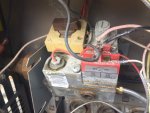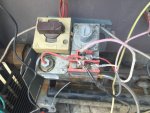Hi everyone, I have an issue with the pilot on my Hayward inground pool heater. I have replaced the old one with a new one...part HAXPLT931. Slight problem.....I couldn't get the pilot tube off the old pilot assembly. I completely stripped the hex connection trying to use wrenches, vice grips, etc. instead of worrying about that connector, I went to Home Depot and got a replacement pressure connector that seemed to work just fine. I put the new pilot tube on using the new connector supplied with the HAXPLT931 part and one connector I purchased at Home Depot.
I was optimistic my troubles were over. I have my heater wide open on the top for ease of access. I lit a match, held down the pilot button/switch and I singed all of the hair on my arm off. The gas coming out of the pilot hole next to the thermopile is obviously too much. It is creating a huge flame. Somehow there is too much gas flowing through the tube. I thought about crimping the tube quite a bit, then decided against the jury rig in favor of "doing it right". The only problem is....I don't know what the issue is. I am thinking somehow I must be missing an orifice of some sort, but I don't recall ever seeing one. I know the connector I got from Home Depot is the right size and don't believe I have any larger gas flow that I can tell.
I am a little disappointed that the new part only came with one of the connectors. IMO, it should always come with both because you can't assume you will be able to get the old one off.
Help!! I can take pictures if needed.
I was optimistic my troubles were over. I have my heater wide open on the top for ease of access. I lit a match, held down the pilot button/switch and I singed all of the hair on my arm off. The gas coming out of the pilot hole next to the thermopile is obviously too much. It is creating a huge flame. Somehow there is too much gas flowing through the tube. I thought about crimping the tube quite a bit, then decided against the jury rig in favor of "doing it right". The only problem is....I don't know what the issue is. I am thinking somehow I must be missing an orifice of some sort, but I don't recall ever seeing one. I know the connector I got from Home Depot is the right size and don't believe I have any larger gas flow that I can tell.
I am a little disappointed that the new part only came with one of the connectors. IMO, it should always come with both because you can't assume you will be able to get the old one off.
Help!! I can take pictures if needed.






